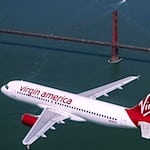Virgin America slows growth as pessimism about competition clouds its future

Skift Take
There are no easy answers for Virgin America, and 2013 will be a critical juncture.
Virgin America has slowed its growth plan amidst some turbulence, and there are lots of analysts who question the airline's viability.
"I'm surprised it has survived this long, given the huge losses accumulated to date," says Scott Hamilton, managing director of aviation consulting firm Leeham Co., mincing no words.
"I don't really see a place in the market for Virgin America," Hamilton says. "The SFO market is well-served by Alaska, United and Southwest. All other big cities are spoken for when it comes to hubs. An airline like Allegiant found a real niche with its business plan. Spirit Air, as an ultra-low-cost carrier, has a nice niche. Frontier Airlines is converting to an ultra-low-cost carrier. What does Virgin truly offer that its competitors don't?"
Founded in 2007, Virgin America saw its net loss widen to $31.7 million in the second quarter of 2012, as reported last month, while RASM dipped 2 percent.
The San Francisco-based airline, privately held and with a minority stake from Richard Branson, is entering a self-described "slower
